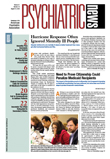Frequent use in psychiatric comorbidity research of lifetime prevalence with mixed-age samples can often produce inaccurate results, several researchers maintain.
Future comorbidity studies that use lifetime prevalence should require determination of age of onset, even if only retrospectively, according to a paper published in the June Archives of General Psychiatry titled“ Lifetime Prevalence and Pseudocomorbidity in Psychiatric Research.”
One of the authors, Chris Hayward, M.D., M.P.H., an associate professor in the Department of Psychiatry and Behavioral Science and director of clinical services at Stanford University, said the article was a recognition that comorbidity in psychiatric illness is an important issue that is drawing increasing amounts of research. However, the increasing use of mixed-age samples in estimating comorbidity could lead to misleading conclusions about the extent of comorbidity.
“We have a methodological concern that applies to many current studies in which comorbidity is estimated,” he told Psychiatric News.
The methodological concern about estimates of comorbidity applies to the use of lifetime prevalence rates for two disorders in mixed-age samples. The authors created a simulated example to demonstrate that even in cases of randomly associated disorders the use of lifetime prevalence with mixed-age samples creates the appearance of nonrandom comorbidity.
Although Hayward declined to identify specific examples of problem studies that have been published, the authors reported that the use of lifetime prevalence to estimate comorbidity is very common, which could put the results of many such studies in serious question.
`Be Suspicious'
“One of the major contributions of this article by Kraemer and colleagues is to alert investigators (and readers) to be suspicious about lifetime prevalence or lifetime history studies,” James Anthony, Ph.D., professor and chair of the Department of Epidemiology at Michigan State University, said in an interview with Psychiatric News.“ Apparently, each generation of psychiatric investigators needs to be reminded that estimation and study of `lifetime prevalence' and `lifetime history' are fraught with perilous difficulties and are best avoided.”
Although the authors said no perfect solution for avoiding pseudocomorbidity exists, one possible way to avoid pseudocomorbidity is to estimate comorbidity in narrower age ranges.
Smaller age intervals are “the best in terms of reducing the bias, but the smaller the age grouping, the less generalizable the results are, because they become more and more narrowly applicable only to people in that age range,” Hayward said.
For example, the National Comorbidity Study (NCS) used 10-year age groupings as part of its design. Although Hayward and the other paper authors found no evidence that NCS researchers used the more narrow age groupings to try to address pseudocomorbidity, the NCS approach was viewed as a good way to avoid pseudocomorbidity problems.
Solution Not Satisfactory
The pseudocomorbidity problem is further reduced with more narrow age groupings, but studies that limit participation to same-age participants are“ not a very feasible solution because you can apply the estimate of comorbidity only to people of that age,” Hayward said.
Other approaches could include following a group of people of the same age over time.
The use of age of onset, even in a cross-sectional study, and Kaplan-Meier survival curves would allow researchers to show the comorbidity at each age because they would have the age of onset for the two disorders being studied by age.
The largest obstacle to the revised approach suggested by the paper's authors, Anthony said, is that it may require a huge boost in the sample-size requirements for epidemiological research on psychiatric comorbidity.
“Necessarily, unless the goal is to produce a stratum-specific estimate only for one to five birth cohorts, the net result of the published recommendation is to move the budget for a national comorbidity survey well beyond the scope of the currently available [National Institutes of Health] budget for such research,” Anthony said.
Problems can arise over the accuracy of age of onset, particularly for disorders that have early onset and when older participants are asked about the past. Hayward maintains that the age-of-onset approach is preferable to no effort to address the problem.
Good estimates of comorbidity can also be found through longitudinal studies that follow participants over time and calculate comorbidity at any given age, with estimates varying by age.
The presence of pseudocomorbidity impacts both researchers and clinicians if disorders thought to involve shared factors or to be caused by another disorder were actually unrelated.
Misinterpreting study results to find comorbidity where there is none may lead to an entire line of research that tries to explain why the disorders are comorbid, when it's very possible they are not comorbid at all.
Pseudocomorbidity also may lead clinicians to make assumptions about the risk for developing a second disorder when little or no risk actually exists.
